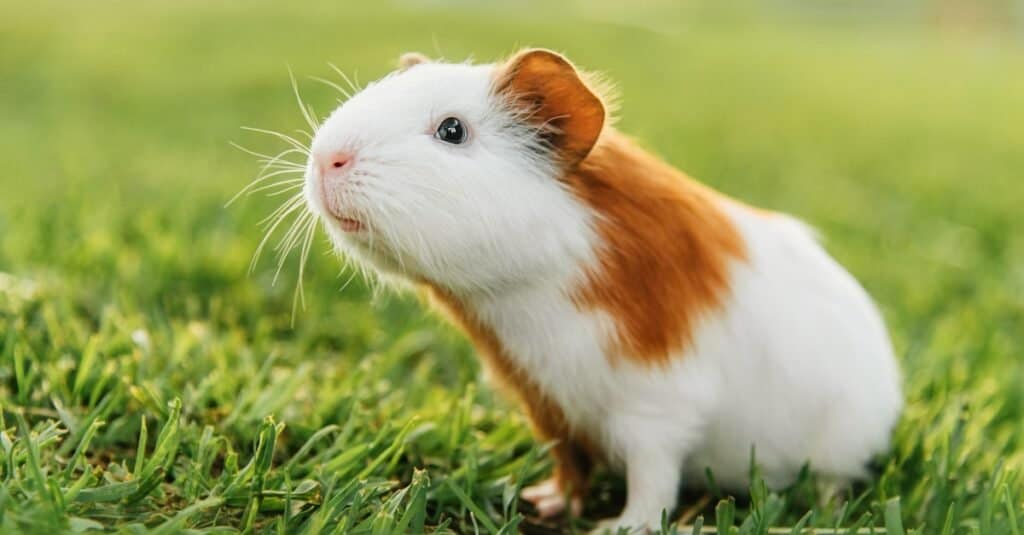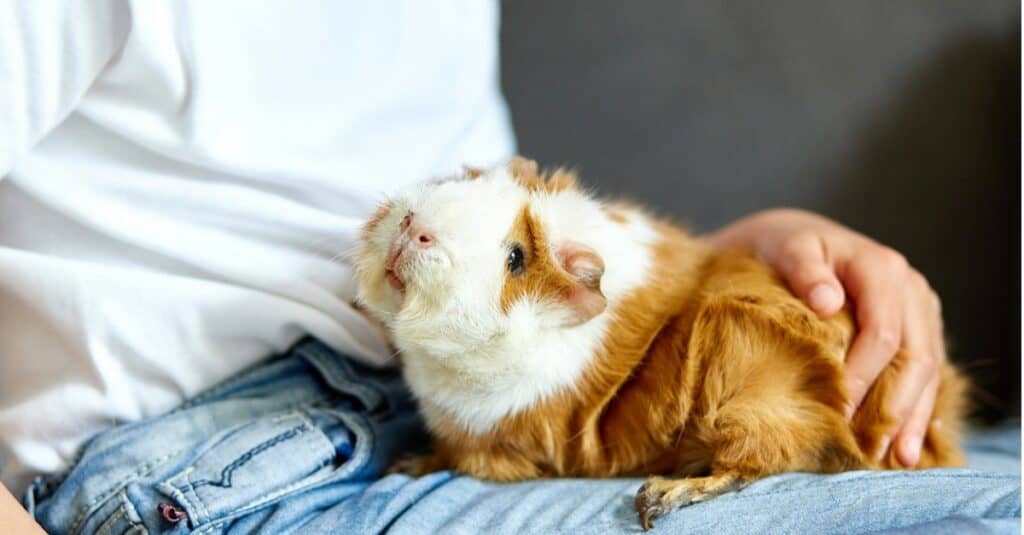Guinea pigs are among the oldest and, some might say, the cutest domesticated animals in the world: sociable, gentle, and pleasant to be around, they can appeal to children and adults alike. Today, there are 13 accepted guinea pig breeds, each varying by the color, texture, and patterns of their fur.
The species we know as the domesticated guinea pig does not exist naturally in the wild. It is entirely a creation of people, artificially molded over millennia to suit our social needs. This species does have wild relatives that still roam the natural habitats of South America, but unlike cats and dogs, these ancestors are rarely encountered by people. It’s very unlikely you would ever see one, even if you did happen to visit their natural habitats in South America. However, anyone can appreciate their long and compelling history that dates back thousands of years. This article will cover where they came from and how they were used throughout history.
Guinea Pig Classification

©Rita_Kochmarjova/Shutterstock.com
The common domesticated guinea pig appears to defy easy classification. It seems to have the shape and sound of a pig but the size of a large rat. The name seems designed to cause just as much confusion as well. But scientists have determined that the guinea pig is actually a type of rodent. This is because the guinea pig has all the defining traits of a rodent, including the presence of incisors on the upper and lower jaws that grow continuously throughout its lifetime. Not everyone has accepted the cavy-rodent connection, however. In the 1990s, some scientists argued that the cavies are distinct enough, from an evolutionary perspective, to warrant classification in their own separate order. But a full genetic analysis done since then supports the notion that they belong in the order of Rodentia.
Caviidae (or simply cavy) is the name of the rodent family to which the guinea pig currently belongs. Members of the cavy family are endemic to all kinds of different locations throughout South America, except for the Amazon. Along with all other cavies, this family also includes the largest living rodent, the capybara, which actually looks a bit like an overgrown guinea pig.
Further down the taxonomical ranking, the domesticated guinea pig is one of six recognized species that belongs to the genus of Cavia. The five other species, which look similar to the common domesticated variety, are called the Brazilian guinea pig, the shiny guinea pig, the intermediate guinea pig, the greater guinea pig, and the montane guinea pig. Some taxonomists recognize three other species of feral guinea pigs that returned to the wild at some point after domestication. There are also four more extinct species known from the fossil record.
The Evolution of the Guinea Pig

©iStock.com/bondarillia
The very first members of the Caviidae family probably evolved around 26 to seven million years ago from marmot-sized rodents that came from North America, Europe, and Asia. Once they arrived in South America, however, this group became the cavy-like animals we know today. Most cavies are characterized by large heads, short but heavy bodies, and barely visible tails. They’re also relatively large compared to many rodents.
The most common locations where they’re found include grasslands, forests, and marshes with plenty of vegetation and grass. Most species prefer relatively low lands, but the montane guinea pig can survive at elevations of up to 16,000 feet. In the wild, they travel together in small herds that consist of a male “boar”, several female “sows,” and their young offspring. This social configuration enables a single male to control reproductive access to several of the females in his herd. Wild guinea pigs are highly active during dawn and dusk, but in order to protect themselves, they seek shelter in the burrows created by other animals during the rest of the day. This is how the wild guinea pigs lived when they were first domesticated.
The Domestication of the Guinea Pig
Based on genetic analysis, the guinea pig was probably first domesticated in the Andean region of South America around 5,000 BC; today, this region corresponds to the countries of Ecuador, Peru, and Bolivia. The exact history is now lost to us, but we do know that the guinea pig was first domesticated from one of the wild species, perhaps the montane guinea pig or some other extinct species, and then systematically selected for appealing traits such as gentleness and docility. Curiously, along with the llama and alpaca, it was one of the few animals ever domesticated in South America.
The guinea pig initially had a variety of different uses to the local people, including companionship, food, and even religious customs. According to one common tradition, guinea pigs were used to diagnose painful illnesses such as arthritis and rheumatism. Black guinea pigs were said to be particularly skilled at this art of diagnosis. The guinea pig held such a central place in the Andean culture that they were exchanged as popular gifts, both as signs of respect and affection. The animal was called a quwi or jaca in Quechua, one of the main language families in the Andean region.
Around the year 500 BC, the guinea pigs began to make their first appearance in folk art and handicrafts. The Moche people, who flourished around 100 to 800 AD, incorporated many animals, including guinea pigs, into their social and religious customs; the statues and art they created with depictions of animals testify to this spiritual and social significance, verging on worshipful. The rise of the Incan civilization from 1200 AD onward likewise had an important effect on the fortunes of the guinea pig. The Incans suddenly began to create new exotic varieties with unique fur colors and textures. Much of the breeds we still know today were originally bred in this creative period.
These animals continued to be used for food and diagnosis, but the Incans seemed to have a particular habit of sacrificing their guinea pigs to the gods as well. Some of these practices endured in remote villages long after the Spanish conquests forcefully ended many Andean traditions.

©Rita_Kochmarjova/Shutterstock.com
The Guinea Pig Goes Global
After the fall of the Incan Empire in the early 16th century, the animal became a very popular export from the Andean region. The first written record of the guinea pig appears from a 1547 account in Santo Domingo (now the capital of the Dominican Republic), where guinea pigs were not native but introduced by people. Later that century, as they spread across the Atlantic, the animals caught the fancy of upper-class Europeans and members of royal courts. One of the greatest early fans was none other than Queen Elizabeth I, who helped to solidify their status as popular and trendy pets.
The animal went by many different names in these early days. The Portuguese called them Porchitas da India, or “little pig from India” (because the Americas were initially mistaken for the Indies). The Germans named them Meerschweinchen, meaning “little sea pigs,” perhaps because they came from overseas. The Latin name porcellus, which is also the scientific name for the species, simply means “little pig.” The French don’t refer to it as a pig at all, but rather as a kind of rabbit.
The English name is likewise a bit of a misnomer, and it’s not entirely clear how it acquired the term. One of the most popular theories is that guinea refers to the cost of the animal. The guinea was a gold coin in 17th century England, composed of metals extracted from the Guinea region of West Africa. This explanation is unlikely, however, because the term was already thought to be in use by the time the coin was first minted. Another explanation is that the animal came to England via a stop in Guinea, or perhaps Guinea might have been common English slang for any foreign location. It’s not entirely clear where the name comes from, but it stuck around long after its initial meaning was lost.
By the 1800s, these animals were being put to use as experimental animals in laboratory tests to study nutrition, diseases, and toxicology, and health products. Their biological similarities to humans and the ease of working with them have made them ideal test subjects. It’s estimated that they have contributed to 23 Nobel prizes for medicine and physiology. They have helped in the discovery of vitamin C and the adrenaline hormone. They have also helped in the development of blood transfusions, antibiotics, asthma medicines, and vaccines. Together, with the so-called “lab rat,” they are closely associated with scientific study and the advancement of medicine.
Today, the animal still flourishes as a lovable pet and companion; millions of them are kept by people across the entire globe. While far removed from their natural habitat, the humble guinea has become one of the most fascinating animals on the planet.
A few things to consider before bringing one home are that they are primarily nocturnal and are most active at dawn and dusk. They are social creatures who enjoy having company. If you are a night-owl ,these may be the perfect pet. However, if you like to get to bed early and rise early, these might not be the best choice.
Up Next…
- Guinea Pig Types: The Ultimate Guide To Guinea Pig Breeds If you are thinking about adding a guinea pig to your family, check out the different options here.
- Guinea Pig Diet: What Do Guinea Pigs Eat? If you have decided on what type of guinea pig you would like, make sure you know how to feed him.
- Guinea Pig as a Pet: How to Care for Your Guinea Pig You’ve chosen the type, you know how to feed him, now make sure you know how to meet all of his other needs.
The photo featured at the top of this post is © Oleg Batrak/Shutterstock.com
Thank you for reading! Have some feedback for us? Contact the AZ Animals editorial team.






